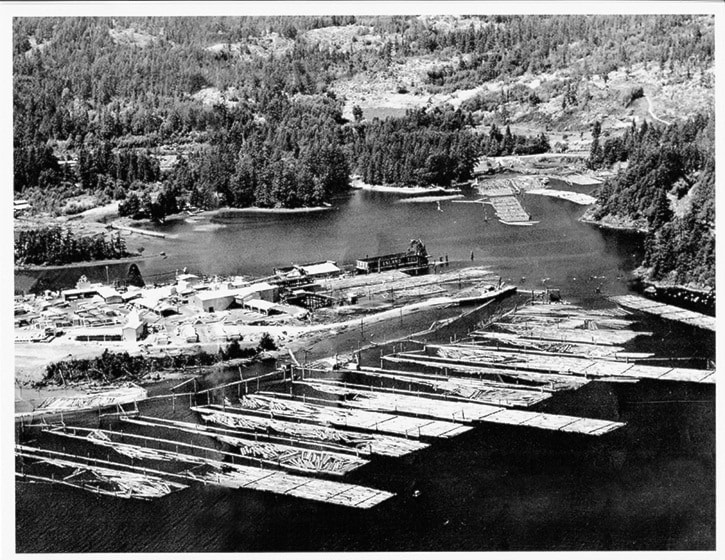Today as we cruise down the hill approaching Coopers Cove when driving out from Victoria, with perhaps a quick glance at the quiet cove, noting small boats and kayaks, we see a background view of a closed-down industrial site.
Probably it’s hard to believe the enormity of the sawmilling enterprise that sustained much of Sooke’s working population for several decades, but this aerial photograph might help. The plane is flying low approaching Goodridge Peninsula in the foreground, heading from the East Sooke side. In the background today you would see the subdivision of Ludlow and Ayum Road, but this 1960s photo was taken long before that subdivision went in.
The enterprise was started by returning Second World War veteran Harry Helgesen in 1946 at Helgesen Road in Sooke, but soon moved to the Goodridge Peninsula site, where they could expand in all directions. When Harry Helgesen partnered with Bill Grunow the mill became Goodridge Sawmill, and later, when Grunow partnered with Hershel Smith, it became Sooke Forest Products. More changes followed, and in 1989 the mill closed.
The photo is centred by an Island Tug & Barge Company chip barge, with two hogfuel barges behind. These barges would be towed to Port Angeles or Crofton, and were generally towed by Doug MacFarlane’s DEMAC. The “green chain” locations are just left of the barges. Milled lumber was trucked across the causeway (at left, out of photo) and hauled to Victoria for shipping, predominantly to the eastern seaboard, with some to local markets.
The extensive array of log booms in the close foreground were the responsibility of booming contractor Len Jones, who kept a crew of boom men employed there for many years. Timber delivered to the site for booming included Douglas-fir, western hemlock, balsam and red cedar. In its later years, the mill cut only cedar, and was regarded as one of the most efficient sawmills in Canada.
In its heyday, the 60s and 70s, the mill employed 400 men in three shifts around the clock. In fact, we residents would often be governed by the mill whistles; for instance the 11 p.m. whistle meant it was bedtime and the 7 a.m. whistle meant time to get up.
Close to the road that you see at far right, observe the dump and logbooms belonging to B.C. Forest Products at the left of the little inlet (there’s a restaurant there today), while on the right, you see the log dump used by logger Ted Shaw. While this site was the source of pay cheques that fed hundreds of Sooke families, that era is long gone.
•••
Elida Peers is the historian of Sooke Region Museum.
